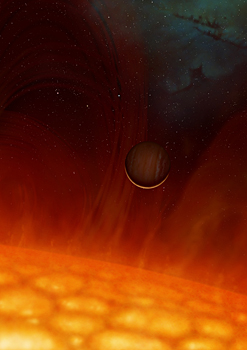
Roberto Silvotti of the Italian National Institute of Astrophysics led the team, which discovered a planet slightly more massive than Jupiter around the star V 391 Pegasi.
The planet orbits this star every 3.2 years, traveling 158 million miles away from the star. It follows an orbit slightly larger than the orbit of Mars. This discovery will be published Sept. 13 in the British journal Nature.
Harry Shipman, Annie Jump Cannon Professor of Astronomy at UD and a member of the team, said the discovery is extremely important. “With 250 planets out there, why is this one interesting? It is the first planet discovered around a star late in its life cycle. This star has previously been a red giant star, which according to conventional wisdom is a planet-eater,” he said. “Also, it is the first planet discovered using a new technique.”
Shipman said that 100 million years ago, V 391 Pegasi was a kind of star known as a red giant. Its surface swelled up to an enormous size, where it would definitely engulf planets like Venus and Mercury, were such planets to be orbiting V 391 Pegasi. Until this discovery, astronomers argued vigorously whether planets like Earth and Mars could survive when the sun becomes a red giant.
Jonathan Fortney of NASA's Ames Research Center in California wrote that “the planet found by Roberto Silvotti and colleagues demonstrates that planets with orbits similar to the Earth's can survive the red-giant expansion phase of their parent star." Fortney prepared a companion piece in Nature's "News and Views" section, which highlights particularly important discoveries.
The observations which led to the discovery of this important planet were obtained, to a great extent, from a collaboration called the Whole Earth Telescope, Shipman said.
The team that discovered it consists of many astronomers from 15 separate countries around the world, all of whom observed this star at the same time in 2003 and some of whom continued to observe the star over the past three years. This team now operates under the leadership of Judi Provencal and Susan Thompson, research associates in UD's Department of Physics and Astronomy, and Shipman. All are astronomers at Mt. Cuba Observatory and UD.
This planet discovery also marks the first successful use of a new technique used to discover planets orbiting distant stars. The vast majority of prior planet hunters spread the light of stars out into a million rainbow colors and looked for very subtle shifts in the wavelength, or color, of features in this rainbow-like pattern, or spectrum, of starlight.Silvotti and his team measured small variations in the light from V 391 Pegasi and found that these light variations came from a highly accurate clock. When the star moves towards the earth, clock pulses are bunched together and arrive more rapidly. When they move away from the earth, they arrive more slowly. The changing arrival times of ticks from these stellar clocks provide indications of the motion of the star as its motion is disturbed by an unseen object.
Three years worth of observations of V 391 Pegasi showed the results of the star's motion back and forth because of the presence of its planet.
The Whole Earth Telescope team has cooperatively observed a variety of types of stars for nearly 20 years. It was founded at the University of Texas and until a few years ago, leadership groups at Texas or at Iowa State University coordinated the team's efforts.
For the past few years, the team's work has been part of the program of the Delaware Asteroseismic Research Center, a unit established at the Mt. Cuba Astronomical Observatory in close collaboration with UD.
"Many of us had hoped that we would find a planet, because the kind of careful measurements we make of these varying stars were just the thing that was needed. It's great to see one at last," Shipman said.


